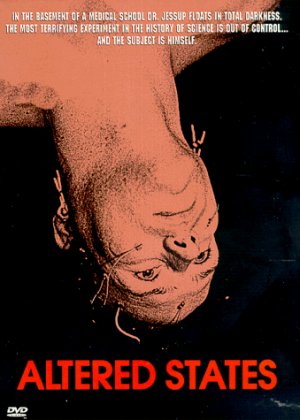
ALTERED STATES
US, 1980, 102 minutes, Colour.
William Hurt, Blair Brown, Bob Balaban, Charles Haid.
Directed by Ken Russell.
Altered States is based on a novel by Paddy Chayevsky (Wedding Breakfast, Party Girl, Network). Chayevsky wrote the screenplay but chose to take the pseudonym Sidney Aaron. The project was initially begun by Arthur Penn but was taken over by Ken Russell. Russell in the '60s had made a number of biographies of film composers in a flamboyant bravura style. This translated into his feature films with adaptations of such novels as Women in Love as well as his biographies and explorations of history, for example The Music Lovers, The Devils, Savage Messiah, Mahler and Lisztomania. He made this film soon after his biography of Valentino.
The film introduces William Hurt to the screen. There is a good supporting Role for Blair Brown as his wife. In the supporting cast are Drew Barrymore as one of his daughters (before ET) and George Gaynes as a doctor (before the Police Academy series).
The film takes as its base a lot of the experimentation of the '60s into the '70s, the exploration of altered states-inducing drugs as well as such experiments as pressure tanks. The film gains strength from Russell's style of making collages out of a range of images from art history and anthropology as well as religion (from Salvador Dali to Hieronymus Bosch - especially surrealistic landscapes, apocalyptic visions, visions of hell).
The film, while taking its plot from the experiments like Timothy Leary and LSD experiments, is basically related to the 19th century classics such as the Frankenstein story as well as Dr Jekyll and Mr Hyde. In fact, when the doctor is transformed in mental states into an ape, the film is an echo of Edgar Allen Poe and the Murders in the Rue Morgue.
The film is an interesting blend of Ken Russell's flamboyant style with American production.
1. The impact of the film? The relationship to the experiments of the '60s and '70s? The '60s culture and drugs?
2. Ken Russell's style, flamboyance and bravura? Paddy Chayevsky screenplays and his writing skills? A satisfying combination?
3. American locations, laboratories and experiments? The domestic sequences? Visits to Mexico? The contrast with the special effects and the editing for the hallucinatory visions?
4. The prologue in the tank, the visuals, the embryo? The dates? The effects?
5. The picturing of the altered states, the psychological background, medical? Scientific experimentation? The relationship with Jessup’s father's death? The religious imagery and the apocalyptic style?
6. The nature of altered states, schizophrenia, mental illness and health, the relationship to mythologies, religion?
7. The character of Eddie Jessup? Harvard background, the research scientist, the experiments? His relationship with Emily? The intercourse sequence and the religious imagery, Christ and the crucifixion? Nine years old, vision of saints? His own lack of belief? His father's death and the cancer? The last word `terrible'? Dispensing with God? The father and his never seeing visions?
8. The hallucinations: cosmic, the fish, the father in the bed, lava, the Bible, the eyes, the face of Christ on his father's face, the burning? Goats, lambs, the crucifix and the sky? Blood and the knife? The Bible cover? Schizophrenics and their hearts being touched by Christ? Sex, harpooned by some raging monk in the act of receiving God?
9. The conventional plot: Eddie and his character, personality, relationship with his assistant, Mason, the monitoring of the experiments by Arthur Rosenberg? His love for Emily, her anthropological work? The marriage, the family? His field trips, the hallucinations? The arguments with Mason against the water tank? The arguments with Emily? The build-up to the divorce? Emily going with the two children to study apes in Africa? His continued experiments, the physical transformation, becoming an ape? The reversion to his human form? Emily's return, his attempts to explain what was happening to him? His own regressions? Fear for Emily? The importance of Emily's love, her transforming him back to normal? Risking her own life for him?
10. The divorce background: dispensing with God, his wanting to become his primordial self, the relationship with the Indians, the mushrooms? The hallucinations? The soul returning to its first soul?
11. The cave, Mexico, the light, the three entering into the cave? The unborn soul emerging? The music?
12. The drugs, the potions, Eddie cutting his hand, the blood, the roots? The fireworks, the cave art? (Eddie and his wife, the tea party, the posture, the ice cream, red suits?) Emily transformed to a lizard, the pain, the dance ritual? Eyes, the snake, the Eucharist? Skulls, fire and psychedelia? The snake strangling? The burning hand? The imagery of lizards, Emily, the wind and the dust, stone and the statues and the dust blown away? Cosmic and infernal imagery, faces and masks? Eclipse, crosses? The echo of Eduard Munch's Scream?
13. The images of birth, being in the tank, in the womb, his being connected with the central console, the monitoring of Eddie's experiences? the tank, blood, the writing, the animal nature being released? His being reconstituted? The physical transformation and the abyss, volcanic? His becoming an ape, the bashing and the chase, the dogs, at the zoo, meat, the souvenirs, the goat and the carcass?
14. Emily's dream, Eddie as the apeman and the linking with her anthropological work?
15. The final resolution? The mask, the primal scream, the light and the glow, the scream of birth? The maelstrom? The shattering, amoeba and cells, colour and sound? Emily holding on to Eddie and saving him?
16. An interesting cinematic experience? Its being anchored in previous decades - a memento of the psychedelic era? A variation on the traditional science fantasy stories and the critique of uncontrolled scientific experimentation?